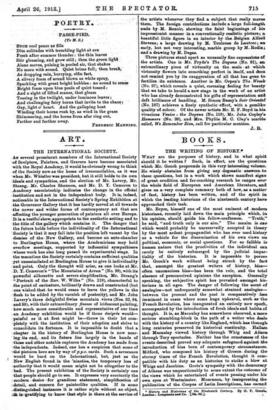ART.
THE INTERNATIONAL SOCIETY.
As several prominent members of the International Society -of Sculptors, Painters, and Gravers have become associated with the Royal Academy, it would be obviously wrong to think of the Society now as the home of irreconcilables, as it was when Mr. Whistler was president, but it still holds to its own ideals and sympathies, and the election of Mr. Lavery, Mr. Strang, Mr. Charles Shannon, and Mr. D. Y. Cameron to Academy associatesbip indicates the change in the official institution and not in the independent body. It is, indeed, noticeable in the International Society's Spring Exhibition at the Grosvenor Gallery that it has hardly moved at all towards the newer and wilder forms of contemporary art that are affecting the younger generation of painters all over Europe. It is a restful show, appropriate to the aesthetic setting and to the title of the gallery which contains it. The danger that the future holds before the individuality of the International Society is that it may fall into the position left vacant by the demise of the New Gallery, and become an ante-chamber to Burlington House, where the Academicians may hold overflow meetings, supported by influential sympathisers whose -work has also long passed its experimental stage. In the meantime the Society certainly contains sufficient qualities 'yet unassimilated at Burlington House to give it individuality Land point. Only the thought will arise, as one looks at Mr. D. Y. Cameron's "The Mountains of Arran" (No. 99), with its _powerful silhouette and severe simplification, Mr. Strang's "Portrait of the Rev. W. Wilke" (No. 119), characterful to the point of caricature, brilliantly drawn and constructed (but
-one wished that be would cease to leave the yellows in the :flesh to be added by the varnish of posterity), and Mr. John .Lavery's three delightful Swiss mountain views (Nos. 82, 84, . and 89), with their extraordinary finesse of iridescent painting,
haw much more considerable and representative of our time an Academy exhibition would be if those Emigres would— painful as it at first might be—throw in their lot com- pletely with the institution of their adoption and strive to consolidate its fortunes. It is impossible to doubt that a chapter in the history of Burlington House is now near- ing its end, and its future lies largely in the hands of those and other notable captures the Academy has made from the independents. Indeed, one has a suspicion that some of the pictures here are by way of p.p.c. cards. Such a severance would be hard on the International, but, just as the New English found in the 'nineties, the temporary loss of authority that it would mean might not be altogether to the bad. The present exhibition of the Society is certainly one that people should go to see. It expresses very succinctly the
:modern desire for grandiose statement, simplification of s;detail, and concern for pa.interlike qualities. If in some ,idistinguished instances it is rather style without an object, sit is gratifying to know that style is there at the service of
the artists whenever they find a subject that really moves them. The foreign contributions include a large full-length nude by M. Renoir, showing the faint beginnings of his impressionist manner in a conventionally realistic picture; a beautiful little figure in an interior by the Belgian Alfred Stevens; a large drawing by M. Toulouse de Lautrec ; 51) early, but not very interesting, marble group by M. Rodin; and a drawing by M. Degas.
Three pictures stand apart as unusually fine expressions of the artists. One is Mr. Pryde's The Dogana (No. 91), au extraordinary piece of virtuosity on the scale at which virtuosity flowers into something perfect in itself, and does not remind you by its exaggeration of all that has gone to. fertilize its existence. Another is Mr. Orpen's The Wreck (No. 97), which reveals a quiet, caressing feeling for beauty that we take to herald a new stage in the work of an artist who has already demonstrated his gifts of representation and deft brilliance of handling. M. Simon Bussy's Soir Oriente (No. 187) achieves a finely synthetic effect, with a gemlike quality of colour. Of the newer artists Mr. E. F. Boyd in his vivacious Venice : the Dogana (No. 158), Mr. John Copley's. Hammers (No. 39), and Mrs. Phyllis M. C. Clay's marble relief, We Remember Zion, call for particular mention.
J. B.


























































 Previous page
Previous page